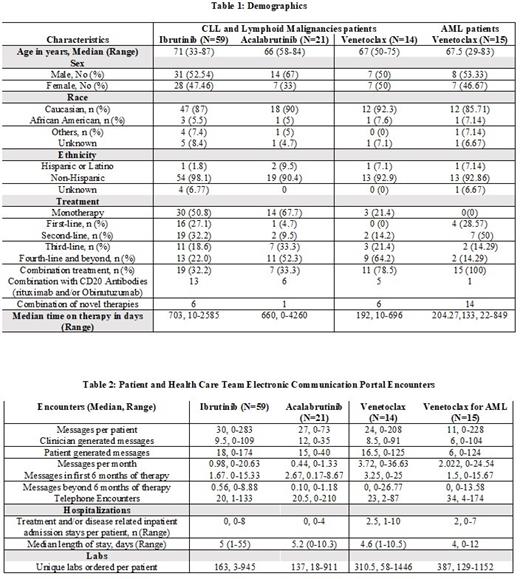Abstract
Introduction
Multiple factors drive specific therapy selection for patients with hematologic malignancies including efficacy, toxicity, patient and physician preferences, comorbid conditions, cost, and logistics. However, the advent of many highly effective and generally well-tolerated targeted therapies for chronic lymphocytic leukemia (CLL) and lymphoid malignancies makes objective distinction between various therapeutic agents more difficult. As a result, the eventual therapy selection is often based on physician preference.
Secure electronic communication portals (ECP) are federally mandated and frequently used in health care. Although important, ECPs impose a significant burden on the entire healthcare team. However, the extent of ECP use on healthcare burden is poorly ascertained particularly in hematology. While limited available data suggests that cancer patients are more likely than urology or family medicine patients to use ECP, healthcare utilization studies have historically not included this metric as a measure of therapy-related healthcare team burden (THTB). Our study not only uniquely evaluates the quantitative impact of ECP use on THTB, it also addresses qualitative domains that are used in ECPs to provide a holistic and granular assessment of THTB.
Methods
Patient and ECP data were retrospectively collected at a comprehensive cancer center after institutional IRB approval. The dataset included 412 patients with CLL and lymphoid malignancies treated with ibrutinib (n=237), acalabrutinib (n=70), and venetoclax (n=105). A subset of these patients with AML treated with venetoclax were also included to address disease and therapy specific issues. By leveraging common taxonomy from published literature, we created multiple domains specific to the evaluable metrics as detailed in the tables and utilized the Naranjo adverse drug reaction probability scale and provider documentation to code each message.
Results
Patients who had at least one patient-initiated or clinician-initiated ECP message thread were included in the final analysis (n=95, 23.06%). Table 1 shows patient, treatment, and disease characteristics. Ibrutinib was used mostly as initial or second-line therapy, while acalabrutinib and venetoclax were mostly used for later lines. We coded 3338 message threads, comprising 3272 patient-generated messages, and 2050 messages generated by 354 unique clinical staff. Our sampled population generated an average of 25.83 messages per patient and our healthcare clinical staff generated an average of 17.96 messages. Table 2 contains domain specific ECP interactions. Patient and healthcare team-generated messages were highest in the first six months of starting therapy and varied with treatment (p<0.01). Venetoclax use was associated with the highest frequency of interactions during the first 6 months of starting therapy. Both treatment-related and unrelated adverse events domains, as well as administrative and supportive care domains, as coded from the ECP, were highest in patients with CLL treated with venetoclax (p=0.005). This was similar for patients with AML treated with venetoclax (p=0.07), suggesting a drug effect rather than the disease process. Patients on venetoclax were also more likely to discuss supportive care and scheduling issues. Adverse event domain specific qualitative measures included comments like "have a scalloped tongue and metallic taste since starting acalabrutinib", "diarrhea, nausea, and vomiting persists since starting the ibrutinib", and "watery diarrhea persists despite the loperamide since starting the venetoclax".
Conclusion
Our study highlights an important but poorly described measure of THTB that can significantly impact therapy selection, especially when multiple therapeutic options with comparable outcomes are available. A non-reimbursed increase in ECP utilization poses significant THTB which is not easily offset by increased staffing efforts and might result in under-utilization of potentially effective therapies, especially in resource limited settings. In addition, our domain-specific appraisal of ECP allows for identification for improvements in healthcare delivery and intervention with structured enhancements that can maximize patient-centered care while decreasing THTB. THTB should therefore include ECP use and be evaluated as part of a comprehensive assessment tool.
Madanat: Geron Pharmaceutical: Consultancy; Blue Print Pharmaceutical: Honoraria; Stem line pharmaceutical: Honoraria; Onc Live: Honoraria. Patel: PVI: Honoraria; Celgene-BMS: Membership on an entity's Board of Directors or advisory committees; Agios: Membership on an entity's Board of Directors or advisory committees. Anderson: Celgene, BMS, Janssen, GSK, Karyopharm, Oncopeptides, Amgen: Consultancy, Honoraria, Membership on an entity's Board of Directors or advisory committees, Research Funding. Awan: Beigene: Consultancy; Incyte: Consultancy; Celgene: Consultancy; Karyopharm: Consultancy; Kite pharma: Consultancy; Dava Oncology: Consultancy; Johnson and Johnson: Consultancy; Verastem: Consultancy; MEI Pharma: Consultancy; Gilead sciences: Consultancy; Pharmacyclics: Consultancy; Janssen: Consultancy; BMS: Consultancy; Cardinal Health: Consultancy; Merck: Consultancy; ADCT therapeutics: Consultancy; Abbvie: Consultancy; Astrazeneca: Consultancy; Genentech: Consultancy.


This feature is available to Subscribers Only
Sign In or Create an Account Close Modal